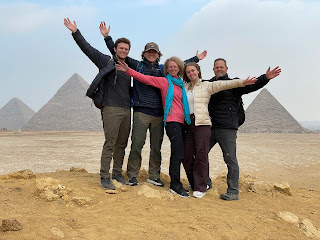Kom Ombo and Edfu Temples - Day 9
After eating breakfast, we disembarked our felucca at 9am. Our driver for the day was waiting on the side of the river for us, and took us 45 minutes to our first stop where we met Sheema, our tour guide, at Kom Ombo.
At Kom Ombo we learned the story of the gods Horus and Sobek. It is a unique temple in Egypt because it is dedicated to both gods, split down the middle and completely symmetrical.
Kom Ombo is two temples in one, each having its own gateways and chapels.
The wicked crocodile god Sobek was worshipped for protection from the ferocious creatures infesting the Nile that devour humans, and for help with predicting the flooding of the Nile.
There are many impressive aspects about the Kom Ombo Temple. One is the discovery of the Egyptian calendar which helped us understand the Egyptian number system.
The calendar is divided into three seasons: Flood, sowing, and harvest. Each season has 4 months and each month 3 weeks of 10 days. The 30 weeks for 12 months add up to a total of 360 days. After adding the 5 holidays corresponding to the 4 main gods, you arrive at 365 days!
Right next to the temple is the crocodile museum, worth 10 minutes to see the ancient, mummified crocodiles.
The Temple of Horus at Edfu, built between 237 and 57 BC, is one of the best-preserved ancient monuments in Egypt. Preserved by desert sand, which filled the place after the pagan cult was banned, the temple is dedicated to falcon-headed god Horus, the avenging son of Isis and Osiris.
The entrance to the Temple of Horus at Edfu
With its roof intact, the Temple of Horus at Edfu is one of the most atmospheric of ancient buildings in Egypt.
Both the driver and our guide commented how empty the road between Aswan and Luxor was - free of traffic - because it was Friday, their weekend. With 95% of tourists traveling the distance between Aswan and Luxor by boat, I preferred the drive. I liked that there was constantly something to look at along the road - things you couldn't see from the Nile.
I love how donkeys are a mainstay here! They are everywhere!
Sugar cane is the largest crop in south Egypt. Along the drive, we saw several dozens of these big tractor loads with kids running behind them, stealing stalks of sugar cane to eat.
Our Luxor hotel is in Luxor's tourist Souk. The hagglers here in Egypt get your attention by telling you a low price - 5 EGP - then change the price to 500 once they have your attention. That's $.20 vs $20! Since our hotel is located in the marketplace, it warns you to "avoid dealing with the people...or you'll be in big trouble!"
The sign in our hotel lobby warning you about hagglers
For dinner at Al Sahaby Lane (the hotel's restaurant) we tried camel, which tasted like stewed beef
Luxor Logistics:
Egypt conveniently interchangeably accepts (untorn) USD but we prefer to get Egyptian pounds out of the ATM. I think charging in USD allows them to mark up the price. JJ Jamaica Felucca's quote was lower in EGP but he wanted the $2000 payment in USD (all of our Egypt private tours, drivers, and entrance fees for five people). He made a good point that we would have a hard time getting that much money out of the ATM all at once.
The cruise ships all visit Kom Ombo at 7am. We arrived at 9:30am with only a couple dahabiya boats.
Edfu Temple is crowded Wednesday and Sunday. Cruise-ship passengers arrive via horse and carriage.
We are staying on the East Bank, where the city is. My first booking was on the West Bank until I couldn't find an appealing place to eat - I realized we would be a bit isolated. The East bank is 40 minutes away because the bridge is so far down the river. There is a ferry, but Sheema said it is for locals.
We are staying at Nefertiti across from Luxor Temple. We like it except it has the absolute worst Wi-Fi. It took 3 hours to upload one picture to the blog, and I can't get our boarding passes. Its two perks are the espresso machine and its cheap, extensive and tasty restaurant, where we ate all of our meals. Breakfast starts at 7am which is late for Egypt (the sites open at 6am).
Al Sahaby Lane, the hotel's restaurant, has seats in the market below as well as on the top floor overlooking Luxor Temple. It is popular so consider making a reservation. As can be expected in a Muslim country, they do not serve alcohol. The menu is extensive with pasta, pizza, grilled meat, and local dishes. The restaurant conveniently takes credit card. Service is not fast so expect your food order to take an hour; the guy next to us was very put off when his pigeon took more than 20 minutes, and refused to eat or pay for it. The food is ridiculously affordable in Egypt. Our family of 5 ate dinner for only $35 including drinks, dessert, espresso, and tip.













Comments
Post a Comment